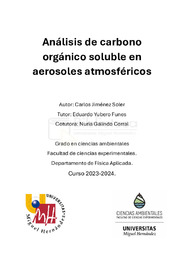Please use this identifier to cite or link to this item:
https://hdl.handle.net/11000/33414Full metadata record
| DC Field | Value | Language |
|---|---|---|
| dc.contributor.advisor | Yubero Funes, Eduardo | - |
| dc.contributor.advisor | Galindo, Nuria | - |
| dc.contributor.author | Jiménez Soler, Carlos | - |
| dc.contributor.other | Departamentos de la UMH::Física Aplicada | es_ES |
| dc.date.accessioned | 2024-10-04T07:53:30Z | - |
| dc.date.available | 2024-10-04T07:53:30Z | - |
| dc.date.created | 2024-06 | - |
| dc.identifier.uri | https://hdl.handle.net/11000/33414 | - |
| dc.description.abstract | En este estudio se han analizado 55 muestras de PM2.5, para obtener información sobre la composición de carbono orgánico soluble presente en esa fracción. Para estimar el carbono orgánico soluble en agua (WSOC) se utilizaron dos métodos (directo e indirecto). Los resultados obtenidos por ambos métodos fueron equivalentes, dando, por tanto validez, a la calidad de los análisis realizados con el método indirecto. Por otra parte, se ha analizado y comparado el carbono orgánico soluble en metanol (MSOC) y el WSOC de las muestras. Los valores obtenidos fueron muy similares, indicando que la mayor parte de los compuestos presentes en las muestras eran de origen secundario (SOC) y confirmando la ausencia de importantes fuentes de combustión. Finalmente, también se ha analizado la evolución temporal de las concentraciones de OC, WSOC y MSOC, observando como la actividad humana y las condiciones meteorológicas influencian directamente las concentraciones diarias de estos compuestos. | es_ES |
| dc.description.abstract | In this study, 55 samples of PM2.5 were analysed to obtain information on the composition of soluble organic carbon present in this fraction. Two methods (direct and indirect) were used to estimate water soluble organic carbon (WSOC). The results obtained by both methods were equivalent, thus validating the quality of the analyses performed with the indirect method. On the other hand, the methanol soluble organic carbon (MSOC) and WSOC of the samples were analysed and compared. The values obtained were very similar, indicating that most of the compounds present in the samples were of secondary origin (SOC) and confirming the absence of important combustion sources. Finally, the temporal evolution of OC, WSOC and MSOC concentrations was also analysed, observing how human activity and meteorological conditions directly influence the daily concentrations of these compounds. | es_ES |
| dc.format | application/pdf | es_ES |
| dc.format.extent | 30 | es_ES |
| dc.language.iso | spa | es_ES |
| dc.publisher | Universidad Miguel Hernández de Elche | es_ES |
| dc.rights | info:eu-repo/semantics/openAccess | es_ES |
| dc.rights | Attribution-NonCommercial-NoDerivatives 4.0 Internacional | * |
| dc.rights.uri | http://creativecommons.org/licenses/by-nc-nd/4.0/ | * |
| dc.subject | aerosol atmosférico | es_ES |
| dc.subject | carbono orgánico | es_ES |
| dc.subject | WSOC | es_ES |
| dc.subject | MSOC | es_ES |
| dc.subject | PM2.5 | es_ES |
| dc.subject | atmospheric aerosol | es_ES |
| dc.subject | organic carbon | es_ES |
| dc.subject.classification | Física Aplicada | es_ES |
| dc.subject.other | CDU::5 - Ciencias puras y naturales::50 - Generalidades sobre las ciencias puras::504 - Ciencias del medio ambiente | es_ES |
| dc.title | Análisis de carbono orgánico soluble en aerosoles atmosféricos | es_ES |
| dc.type | info:eu-repo/semantics/bachelorThesis | es_ES |

View/Open:
TFG-Jiménez Soler, Carlos.pdf
1,17 MB
Adobe PDF
Share:
.png)
